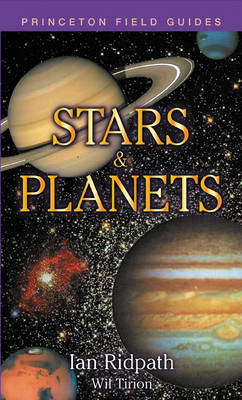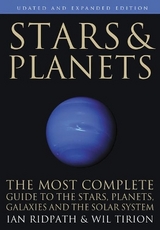
Stars and Planets
Seiten
2001
Princeton University Press (Verlag)
978-0-691-08912-6 (ISBN)
Princeton University Press (Verlag)
978-0-691-08912-6 (ISBN)
- Titel erscheint in neuer Auflage
- Artikel merken
Zu diesem Artikel existiert eine Nachauflage
In this new edition of their classic guide, Ian Ridpath and Wil Tirion bring the night sky down to earth with brand new sky charts, diagrams, and photos that enrich the clear, engaging text. Stars and Planets will delight both latent astronomers who have yet to touch a telescope and the more star-s
In this new edition of their classic guide, Ian Ridpath and Wil Tirion bring the night sky down to earth with brand new sky charts, diagrams, and photos that enrich the clear, engaging text. Stars and Planets will delight both latent astronomers who have yet to touch a telescope and the more star-sawy who have spent many a night outside craning their necks behind a lens. The introduction presents the basics of astronomical observation while answering such questions as: How did constellations come to be? Do the stars within them have anything to do with one another? Do stars really flicker? Next comes the book's centerpiece: an excellent series of maps of the night sky from hemisphere to hemisphere, month to month; and, above all, charts showing all 88 constellations, including some 5,000 stars. The text vividly relates the human history behind each constellation and notes their most prominent stars while offering sundry stimulating facts. The second section focuses on the astrophysics behind stars, galaxies, the sun, the planets, comets and meteors, and more. Striking full-color photos, maps, and illustrations appear on almost every page.
The guide concludes with helpful tips on the optical tools of the trade and on astrophotography. Astrophysicists and amateur skywatchers agree that Stars and Planets is simply the most user-friendly, compact source of celestial information available. No one should leave home at night without it. - Up-to-date full-color photos and data, including recent planetary images - Monthly maps of the night sky as seen from latitudes throughout the world - Charts of all 88 constellations, with data and notes on bright stars and other objects of interest - Illustrated introduction to stars, nebulae, galaxies, and the solar system - Advice on choosing and using binoculars and telescopes
In this new edition of their classic guide, Ian Ridpath and Wil Tirion bring the night sky down to earth with brand new sky charts, diagrams, and photos that enrich the clear, engaging text. Stars and Planets will delight both latent astronomers who have yet to touch a telescope and the more star-sawy who have spent many a night outside craning their necks behind a lens. The introduction presents the basics of astronomical observation while answering such questions as: How did constellations come to be? Do the stars within them have anything to do with one another? Do stars really flicker? Next comes the book's centerpiece: an excellent series of maps of the night sky from hemisphere to hemisphere, month to month; and, above all, charts showing all 88 constellations, including some 5,000 stars. The text vividly relates the human history behind each constellation and notes their most prominent stars while offering sundry stimulating facts. The second section focuses on the astrophysics behind stars, galaxies, the sun, the planets, comets and meteors, and more. Striking full-color photos, maps, and illustrations appear on almost every page.
The guide concludes with helpful tips on the optical tools of the trade and on astrophotography. Astrophysicists and amateur skywatchers agree that Stars and Planets is simply the most user-friendly, compact source of celestial information available. No one should leave home at night without it. - Up-to-date full-color photos and data, including recent planetary images - Monthly maps of the night sky as seen from latitudes throughout the world - Charts of all 88 constellations, with data and notes on bright stars and other objects of interest - Illustrated introduction to stars, nebulae, galaxies, and the solar system - Advice on choosing and using binoculars and telescopes
Ian Ridpath, an amateur astronomer, is an author and broadcaster on stars and planets for a general audience. He is the editor of among other titles, Norton's Star Atlas, The Oxford Dictionary of Astronomy, and The Monthly Sky Guide. Wil Tirion is among the world's foremost celestial photographers and illustrators. He has worked with the author on the illustrations for all the titles above, and more.
| Reihe/Serie | Princeton Field Guides |
|---|---|
| Illustrationen | Wil Tirion |
| Zusatzinfo | 142 charts, 95 color photos, 45 figures |
| Verlagsort | New Jersey |
| Sprache | englisch |
| Maße | 114 x 191 mm |
| Gewicht | 680 g |
| Themenwelt | Sachbuch/Ratgeber ► Natur / Technik ► Weltraum / Astronomie |
| ISBN-10 | 0-691-08912-4 / 0691089124 |
| ISBN-13 | 978-0-691-08912-6 / 9780691089126 |
| Zustand | Neuware |
| Haben Sie eine Frage zum Produkt? |
Mehr entdecken
aus dem Bereich
aus dem Bereich
Perspektiven auf die Menschheit
Buch | Hardcover (2024)
Klett-Cotta (Verlag)
25,00 €
auf der Suche nach neuen Planeten und außerirdischem Leben
Buch | Hardcover (2024)
Droemer (Verlag)
24,00 €



